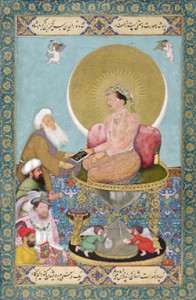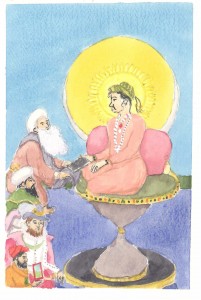In our week focused on pre-modern Muslim spiritual and political authority, one of the examples we looked at was that of Akbar and the Mughals. Asher’s article discussed how Akbar and his descendants drew on both their political power and the spiritual authority of the Sufis to legitimize their rule. Akbar’s advisor Abu al-Fazl honed illumination philosophy to cast Akbar as the Perfect Man, an enlightened leader who serves as both political ruler and spiritual guide to his subjects. Akbar soon secured the power to decide religious interpretations for the ulama and was portrayed as a devotee/member of the popular Chishti order of Sufis, securing his claim to spiritual authority. Through paintings and architecture, Akbar’s spiritual authority was visually depicted with light imagery. Though Jahangir had Abu al-Fazl assassinated, he was happy to expand on Fazl’s philosophy and imagery. I wanted to convey this light imagery and also learn more about the art of Mughal miniatures.
In my painting, which is based off of the Mughal miniature “Jahangir Preferring a Sufi Shaikh to Kings”, Jahangir displays both his spiritual and political power. Jahangir sits above both the kings and the Sufi shaikh, indicating his superior status temporally and spiritually. The halo marks him as a Perfect Man, who radiates the divine light of God. In choosing the Sufi over the royalty, Jahangir makes two points. One, he values spiritual and religious authority over political power. Two, he can choose to prefer the Sufi shaikh because he is so powerful that the kings must come to visit him. Jahangir also sits on a throne made of an hourglass, showing that he transcends the temporal world.
Catherine Asher, “A Ray from the Sun: Mughal Ideology and the Visual Construction of the Divine
 ” in M. Kapstein, The Presence of Light: Divine Radiance and Religious Experience, ed. Matthew T. Kapstein (Chicago: University of Chicago Press, 2004), 161–93.
” in M. Kapstein, The Presence of Light: Divine Radiance and Religious Experience, ed. Matthew T. Kapstein (Chicago: University of Chicago Press, 2004), 161–93.

Jahangir Preferring a Sufi Shaikh to Kings, ca. 1615-18, Signed by Bichitr. Held by the Freer Gallery of Art, I took this image from their website

Post a Comment